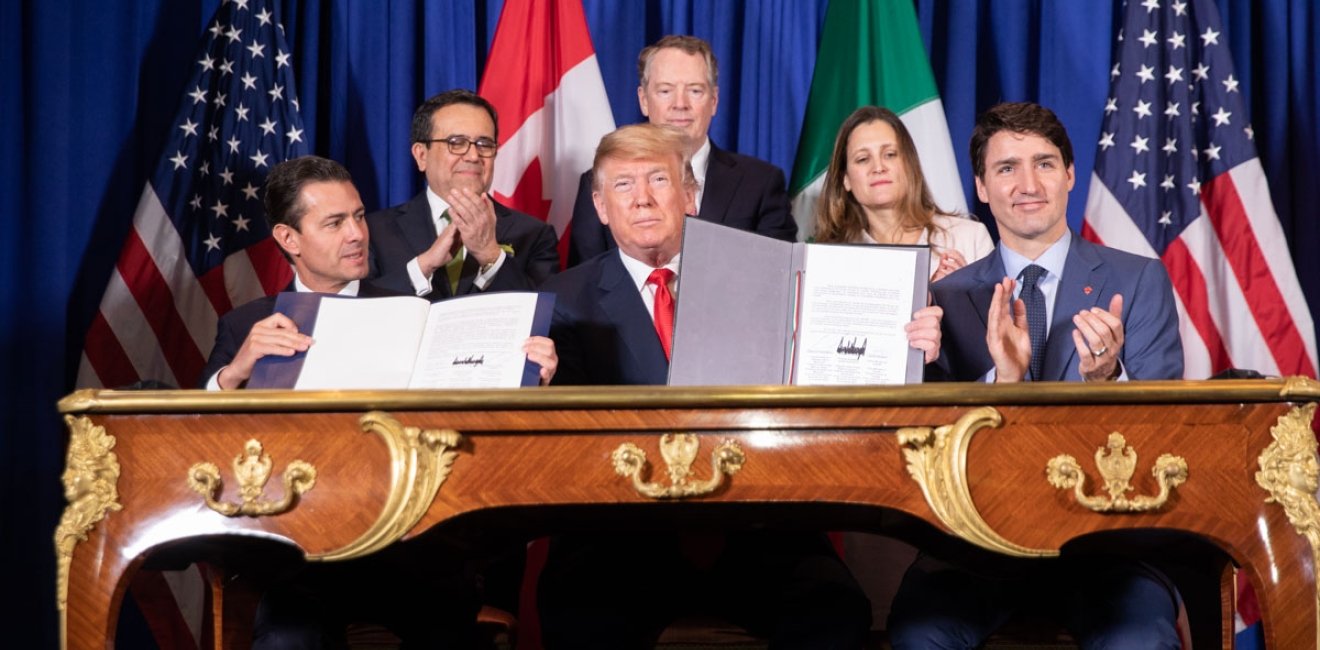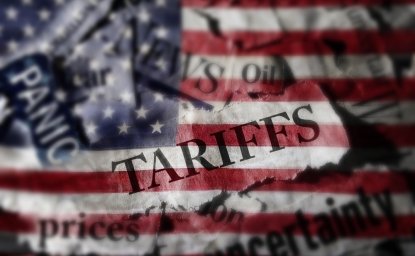President Donald Trump started threatening Canada with tariffs following his election victory, and although a 25 percent tariff on Canadian exports to the United States was not among the executive orders issued on inauguration day, they could be imposed as soon as February 1, or perhaps never.
Welcome back to the Trump administration.
Yet how should Canada respond? Canadian Prime Minister Justin Trudeau tried a personal visit with Trump in Florida to which he brought commitments to invest more in border security, immigration enforcement, and combatting drug trafficking of fentanyl and other drugs. On these priorities, Trudeau pledged $1.3 billion in new funding, but the president-elect kept demanding more.
Following Trudeau’s resignation announcement on January 6 (effective when he is replaced as Liberal Party leader in a party contest on March 9), Canada has been in a leadership quandary. Parliament is prorogued – not meeting, and with no question period where opposition parties can challenge the government – and absent from the debate about what to do next. While the Liberals’ choice will produce a new prime minister, a federal election must be held by October 20 and may come sooner once Parliament starts a new session on March 24 if the opposition passes a motion of no confidence to bring the government down.
Provincial premiers have spoken up while Ottawa was preoccupied. Ontario Premier Doug Ford suggested a bilateral negotiation on trade and security excluding Mexico which is not aligned with the United States on China, which Canada is. Ford proposed a “Fortress Am-Can” incorporating national security and economic security for both countries. And when President Trump began talking about buying Greenland and taking back the Panama Canal, Ford caused a sensation by sporting a ballcap that read: CANADA IS NOT FOR SALE.
Alberta Premier Danielle Smith also weighed in, seconding Ford’s doubts about Mexico. Her province is Canada’s leading energy producer and energy is Canada’s number one export to the United States. But Smith has rejected calls from Ford and other premiers to cut off energy supplies to the United States should Trump make good on his tariff threat. For the energy sector, reliability is akin to credibility, and once lost it is hard to regain. Smith’s dissent has made the provinces, like the parties in Ottawa seem divided.
Divide and conquer is a negotiating tactic that Trump knows too well. He has premiers fighting, Ottawa in turmoil, and Canadians sniping at Mexicans.
The Trudeau government has developed a list of US products for tariff retaliation if the United States imposes a crippling 25 percent tariff on Canadian products. Businesses and consumers are bracing for a trade war that would send both groups to global markets in search of substitutes for tariffed items and new customers for products made more expensive by tariffs. If prolonged, a US-Canada trade war would reorient supply chains, investment patterns, and careers.
In the near term, a US-Canada trade war would fuel inflation. That is because in today’s economy the United States and Canada are less like trade partners and more like coworkers that make hundreds of thousands of products together. Tariffs would add to the cost of production, and it would take time for companies to adjust, meaning that prices would rise for consumers for everything from vegetables to video games to vehicles. In the medium term, firms would cut costs to remain competitive in their domestic market (since reciprocal tariffs would price them out of export markets) and one way to do so would be to lay off workers. Not just blue-collar workers who can be replaced by machines, but white-collar workers who can be replaced by artificial intelligence systems.
Time is a critical factor in how this trade war could unfold. US Treasury Secretary Scott Bessent suggested a gradual application of tariffs at 2.5 percent per interval. This would allow firms to adapt and soften the blow to competitiveness. It would also allow time for negotiations. If, as US Secretary of Commerce Howard Lutnick claimed, the goal of the tariffs is to prompt Canada and Mexico to improve border security, then a gradual application of tariffs will keep the pressure on Ottawa and Mexico City to do more.
Juan Villasmil, writing in The Spectator, offers another explanation for the tariffs. Citing Trump adviser Peter Navarro, Villasmil suggests that Trump seeks the return of “The American System” a trade and fiscal policy combination that was employed by Henry Clay to develop the United States from 1820 until 1890 and the closing of the American frontier. Often described as a prototype of what 20th century development economists called “Import Substitution Industrialization” Clay’s investment in domestic infrastructure and establishment of a Bank of the United States was funded by a high tariff that not only raised revenue but also led domestic manufacturing to gain economies of scale within the domestic market that allowed them to compete with and even excel the efficiency and quality of imported goods.
The problem with the Villasmil/Navarro argument is that the development of domestic substitutes for imported goods require investment by firms, even foreign firms, in domestic production to replace imported goods. Investors base their decisions to some extent on their assessment of political risk, and in the case of Trump tariffs, an important consideration is how long tariffs will remain in place. To invest billions of dollars in US production, firms will need to be confident that the tariffs that make production in the United States necessary will remain in place. Will they remain after 2028? Or even after 2026?
In a strategic sense, time favors the defender and Trump’s tariffs make the United States the aggressor. Traditional protectionism helps domestic producers to compete by raising the price of imports. Trade liberalization has led to economic integration and co-production and as a result, many firms will not find domestic sources of goods to make up for the more expensive imports from Canada. Unless investors believe the tariffs will remain in place, they will not fund the creation of domestic substitutes for imported goods. And Canadian firms could turn to China and other low-cost producers to find replacements for American imports.
China is likely to benefit from a North American trade war in three ways. First, economically, as China’s exporters make inroads into the Canadian and Mexican markets. Second, China will benefit from the fragmentation of the North American trade bloc that has allowed the United States to remain competitive despite higher prevailing wages, higher environmental, labor, and quality standards than China has had during its remarkable rise to Great Power status. Third, China will remind countries aligned with the United States that if this is how Washington now treats Canada, China is a better friend to have.
This raises the question of how long the United States can sustain a trade war against its neighbors. Like Vladimir Putin’s invasion of Ukraine, bold and decisive strikes can turn into costly and drawn-out wars of attrition. Midterm elections in 2026 will be an early referendum on Trump’s trade policies. If Republicans suffer an electoral defeat in 2026, Republican candidates in 2028 will campaign in opposition to Trump policies and legacy.
What Next?
The problem with these scenarios is that they treat Trump tariffs as so obviously self-destructive that they will never happen and so are a counsel to do nothing. Canada cannot afford to be complacent or calm with so much at stake. Neither can US business.
One of the greatest achievements of the first Trump term was the negotiation of the United States Mexico Canada Agreement (USMCA), an agreement that covers more than just trade and investment and retains broad bipartisan congressional support. The USMCA faces a mandated review by the three countries by 2026 and Trump has suggested starting the review early sometime in 2025. In Ottawa and in Mexico City, the review seems pointless since a trade war would break the letter and spirit of the USMCA. Under such circumstances, the USMCA review will resemble a wake.
But the USMCA might yet give the three countries an alternative to a trade war. Canada and Mexico should agree to start the review early and propose to address the Trump administration’s concerns as part of renegotiation of the agreement. The agenda could include border security cooperation. After all, labor and environment were left out of the Canada US Free Trade Agreement and NAFTA, addressed through side agreements proposed by President Clinton as part of NAFTA ratification before being incorporated fully inf the USMCA. Border security has been discussed bilaterally and trilaterally by the NAFTA partners through the Security and Prosperity Partnership of the George W. Bush administration and the Beyond the Border Working Group during the Barack Obama administration. Adding border security commitments to a revised USMCA would break new ground but not be unprecedented in principle.
Before negotiating a truce, there must be a cease fire. Canada and Mexico should not agree to review or renegotiate the USMCA early or ever unless the Trump administration sets aside the 25 percent tariff threat. It will require resolve and a united front by leaders in Canada and Mexico to hold to this precondition. But without it, the USMCA in its current form is meaningless and beyond repair.
Eight years ago, Trump threatened to withdraw from NAFTA unless Canada and Mexico agreed to renegotiate its terms. Then as now, the debate focused on the threat rather than the invitation to negotiate a new and better deal.
Covering the 2016 election, journalist Selena Zito observed that Trump opponents took him literally but not seriously while his supporters took him seriously but not literally. Will Trump literally start a trade war in 2025? Is he serious about a deal to make the USMCA better for Americans? We will soon know the answer.
Author


Canada Institute
The mission of the Wilson Center's Canada Institute is to raise the level of knowledge of Canada in the United States, particularly within the Washington, DC policy community. Research projects, initiatives, podcasts, and publications cover contemporary Canada, US-Canadian relations, North American political economy, and Canada's global role as it intersects with US national interests. Read more







